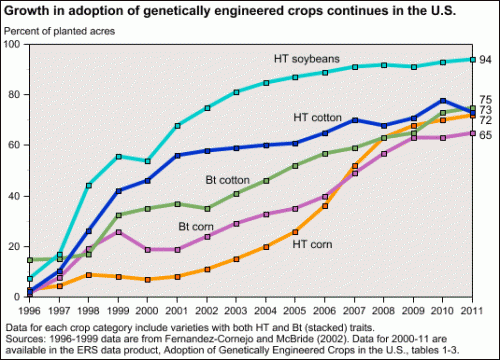I was a member of the FDA Food Advisory Committee when the agency approved production of genetically modified foods in the early 1990s.
At the time, critics repeatedly warned that widespread planting of GM crops modified to resist Monsanto’s weed-killer, Roundup, were highly likely to select for “superweeds” that could withstand treatment with Roundup.
I wrote about this problem in Safe Food: The Politics of Food Safety. I added this update to the 2010 edition:
Late in 2004, weeds resistant to Monsanto’s herbicide Roundup began appearing in GM plantings in Georgia and soon spread to other Southern states. By 2009, more than one hundred thousand acres in Georgia were infested with Roundup-resistant pigweed. Planters were advised to apply multiple herbicides, thereby defeating the point of Roundup: to reduce chemical applications.
Today, the idea that planting of GM crops is “widespread” is an understatement.

So, according to Reuters, is Roundup resistance.
Weed resistance has spread to more than 12 million U.S. acres and primarily afflicts key agricultural areas in the U.S. Southeast and the corn and soybean growing areas of the Midwest.
Many of the worst weeds, some of which grow more than six feet and can sharply reduce crop yields, have become resistant to the popular glyphosate-based weed-killer Roundup, as well as other common herbicides.
This is not a trivial problem. As the Ottawa Citizen explains,
The resilience of nature is evident across almost five million hectares of superweed-infested U.S. farmland. Some runaway weeds in the southern U.S. are said to be big enough to stop combines dead in their tracks.
How is the chemical industry responding to this threat? Zap it harder!
The industry is pressing the U.S. and Canadian governments to approve GM corn engineered to resist 2,4-D.
Remember 2,4-D? It was the principal ingredient in Agent Orange, the defoliant used during the Vietnam War. Although the health problems it caused have been attributed to contamination with dioxin, the uncontaminated chemical has also been associated with illness in some studies (the Wikipedia entry has references).
The chemical industry maintains that 2,4-D is safe at current usage levels. Maybe, but Ontario bans its use on lawns, gardens, and in school yards and parks. Weeds resistant to 2,4-D have been identified since the 1950s.
Is pouring more toxic herbicides on food crops a good idea? These chemicals cannot be healthy for farmworkers or for soil or groundwater.
Organic agriculture anyone?
Addition: Fred Kirschenmann, Distinguished Fellow at the Leopold Center at Iowa State and organic farmer says in an e-mail:
The other issue that has weed scientists concerned is the fact that 2-4-D is known to be much more invasive than many other herbicides—it can drift in the air for long periods of time and land on many unintended crops.
2-4-D has been identified as the main cause for destroying the grape industry in Iowa—in the 1940’s Iowa was the 4th largest grape producing state in the nation, and then was virtually reduced to zero.
Clearly if 2-4-D is going to be the “answer” to Roundup Ready resistance it will now be used in much larger quantities than in the 1950’s and is not only likely to destroy the rebounding grape production (I think some 200 acres now) and the 8 wineries in Iowa, but will make it extremely difficult to grow vegetables, which will not be good news for the burgeoning CSA/farmers Market industry that has emerged in recent years.



